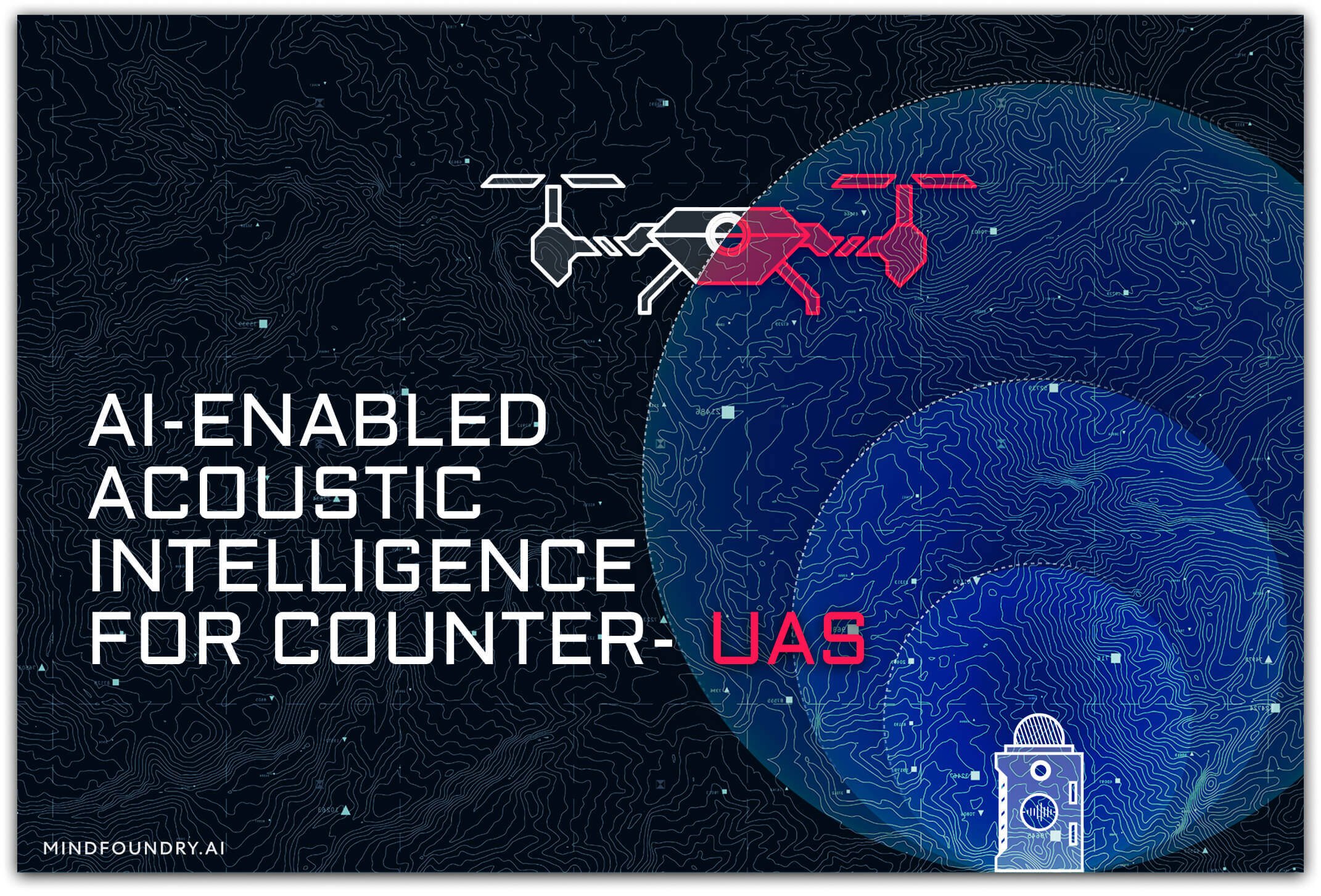AI-enabled Acoustic Intelligence for Counter-UAS
Unmanned Aircraft Systems (UAS) are now a staple of modern warfare, now responsible for 60% of targets destroyed in the Ukraine-Russia war....
5 min read
 Syreeta Cummings
:
Apr 10, 2025 10:55:23 AM
Syreeta Cummings
:
Apr 10, 2025 10:55:23 AM

Once the stuff of science fiction, the war in Ukraine has provided a stark demonstration of how drone warfare is now a very real and deadly phenomenon. UAS are being deployed in unprecedented numbers to conduct reconnaissance, strike targets, and establish superiority on the battlefield. As the war has become more attritional and prolonged, these systems have become more sophisticated, more prevalent, and more varied, and their importance to both sides has grown exponentially. Both Ukraine and Russia are able to produce as many as 4 million drones every year, and they have been transformed from “performing specialised functions to becoming one of the most important and widely used weapons on the battlefield.”
Just as developing, manufacturing, and using UAS have become key facets of military strategy, so have methodologies for Counter-Unmanned Aerial Systems (C-UAS). C-UAS can broadly be split into two categories:
In this piece, we will focus on the first part and outline the most prevalent technologies and methodologies. C-UAS detection comes in many forms, each with its benefits and limitations, but as UAS become more widespread, not just in Defence but in society in general, establishing detection methods that are effective, scalable, and resilient has become increasingly important and urgent.
Radar: involves using radio waves to detect the physical presence of drones. Radar systems emit radio waves that bounce off objects, including UAS, and return to the radar system, providing information about the object's location, speed, and size. Radar systems are widely used by military forces thanks to their ability to detect objects at long distances and in various weather conditions.

Radio waves are sent out, bounce back off the drone, and return to the radar system.
However, radar systems have limitations. Detecting small drones can be challenging against background noise, especially at longer ranges, as radar signals become weaker. Ground clutter and environmental factors can cause false positives, as radar can’t distinguish between a drone and a bird, for example. The systems themselves can also be expensive (some can cost upwards of $300 million) and complex. Furthermore, radar detection systems emit active frequencies that can be both detected and countered by adversaries.
Radio Frequency (RF): involves monitoring the communication signals between a drone and its operator. This allows for the identification and tracking of active drones within a certain range. RF detection can be effective in detecting drones that are actively transmitting control signals or video feeds, providing real-time information on their location and activity.
.jpg?width=750&height=422&name=Radio%20Frequency%20(RF).jpg)
The RF system "listens" for the communication signals between the drone and its operator.
However, RF detection systems are susceptible to jamming themselves, which can disrupt the communication links and render the detection system ineffective. They are also less effective against autonomous drones that do not rely on constant communication with an operator. RF detection is also powerless to stop one of the latest innovations in the Ukraine-Russia war: “jamming-proof” fibre-optic drones that enable operators to navigate with crystal-clear visuals and complete immunity from disruption or interference.
Furthermore, the range and effectiveness of RF detection can be significantly reduced in cluttered and contested environments or areas with high radio frequency interference.
Visual Detection (Electro-optical/Infrared): perhaps the most common methodology for C-UAS is to deploy cameras and thermal imaging. Cameras can be inexpensive and easy to operate, and recent advances in optical sensor technology have improved resolution and, therefore, range. Thermal imaging detects heat signatures, enabling the detection of these systems even in low-light conditions.
A key benefit of visual detection is the detailed imagery that modern cameras can provide, allowing for accurate identification and tracking of drones. This has been dramatically enhanced by the emergence of AI technology, such as computer vision, for greater image detection capabilities.

The drone is detected when it enters the camera's line of sight.
However, both optical and infrared image detection methods rely on a clear line of sight, making them vulnerable to obstruction by buildings, trees, or weather conditions like fog and rain. This limits their utility in physically unpredictable and inconsistent environments. Nighttime detection can also be challenging without thermal imaging, and even with it, its effectiveness can be limited in obscured environments. Finally, even though significant resources have been devoted to developing AI and Machine Learning for object detection and classification, the technology still lacks the reliability needed to be consistently effective for C-UAS.
Acoustic Detection: involves identifying, tracking, and classifying drones based on the unique acoustic signatures that every UAS generates. It involves using sensors, like a small microphone, to capture sound waves generated by drones, such as the hum of motors or the whirring of propellers.
Acoustic detection has several key advantages that distinguish it from other C-UAS methods. First and foremost, it enables operators to identify threats beyond their line of sight where physical obstacles or adverse weather conditions obscure their vision. Secondly, acoustic detection proves effective against threats that are immune to RF detection, such as fibre-optic drones, a critical advantage as these drones have become increasingly common and deadly, as evidenced by their deployment in the Ukraine-Russia war. Its adaptability to various environments, including contested and cluttered areas, further solidifies its effectiveness. Finally, it offers a cost-effective solution compared to more expensive systems, like radar.
However, detection using acoustic signatures comes with three principal challenges. The first is environmental complexity. Sounds vary in intensity, propagate in non-linear pathways, and are affected by numerous factors, including weather, temperature, and varying terrain. Sounds also arrive from all directions, near and far, and the resulting signals detected by any sensor are a combination of many different sources.
The second problem is cognitive load. The environments in which C-UAS is necessary are often stressful, high-stakes, and require rapid decision-making. Adding massive volumes of data—each with differing formats and levels of relevance—compounds this problem. Instead of aiding the operator, poorly designed systems can inadvertently overload them, increasing the likelihood of errors or delays in critical moments.
The third problem is evolving threats. Drone technology has become drastically more sophisticated and varied in recent years. At the start of the conflict, Ukraine relied on foreign-made drones, such as the Turkish-made Bayraktar TB2, principally for tasks like reconnaissance. Now, 96% of the drones the Ukrainian military uses are domestically produced, and it is estimated that about 100 different types of drones are in use, ranging from toy-sized systems to models with wingspans of almost 20 meters. Against a backdrop of increasing numbers of UAS, and as airspace becomes more congested and unpredictable, the task of acoustic detection becomes more challenging.
Acoustic detection is a valuable tool for C-UAS, but only if these three challenges can be overcome. Thanks to the recent rapid advancements in AI technology, though, we can simplify the environment, reduce the cognitive burden on operators, and detect threats even as they evolve and adapt. When combined with AI, we can go from acoustic detection to something far more powerful and effective for C-UAS. Acoustic Intelligence.
AI-enabled Acoustic Intelligence for C-UAS
Acoustic Intelligence in Defence is a discipline that involves collecting and analysing acoustic information to locate and identify threats and enhance strategic decision-making. The integration of AI and Machine Learning into acoustic detection workflows enables true acoustic intelligence whereby environmental complexity, cognitive overload, and evolving threats are all mitigated to create real acoustic intelligence for truly effective C-UAS.
For example, advanced signal processing techniques and AI algorithms can analyse complex sound patterns, filtering out environmental noise to reduce complexity and isolate drone-specific sounds, even from multiple drones simultaneously. By comparing these acoustic signatures to a database of known drone sounds, the system can accurately determine the type, size, and location of the drone in real time.
Acoustic signatures can be converted into visual representations of the sound, like spectrograms, enabling computer vision techniques to identify patterns and signals of interest so that an operator can use their domain expertise to detect the sound of a UAS. By removing the background noise and allowing them to focus on the most important signals, the cognitive burden on operators can be drastically reduced.
Machine Learning also opens up the possibility for continuous improvement in UAS detection. As new drone types are encountered, this information can be fed back into the system to refine and improve its detection capabilities so that even as threats evolve, the system still maintains its ability to detect them.
The last few years have clearly shown us that C-UAS is and will continue to be a strategic necessity, especially in Defence. The techniques listed above each have their benefits, but effective C-UAS will require a combination of multiple sensors to mitigate their respective limitations. Whilst acoustic detection can detect and track threats that may emit no signature other than sound, the true value of acoustic intelligence will be realised in the AI-enabled correlation of data feeds from multiple sensor types, mitigating each other’s limitations and complementing each other’s strengths, so that no threat goes undetected and our skies are kept safe and secure.
Interested in AI's potential to enhance Counter-UAS? Get in touch.

Unmanned Aircraft Systems (UAS) are now a staple of modern warfare, now responsible for 60% of targets destroyed in the Ukraine-Russia war....

In Defence and National Security, mission-critical data often emerges from a multitude of different sensor types. With AI, we can bring this...

When used by malicious actors or without considerations for transparency and responsibility, AI poses significant risks. Mind Foundry is working with...